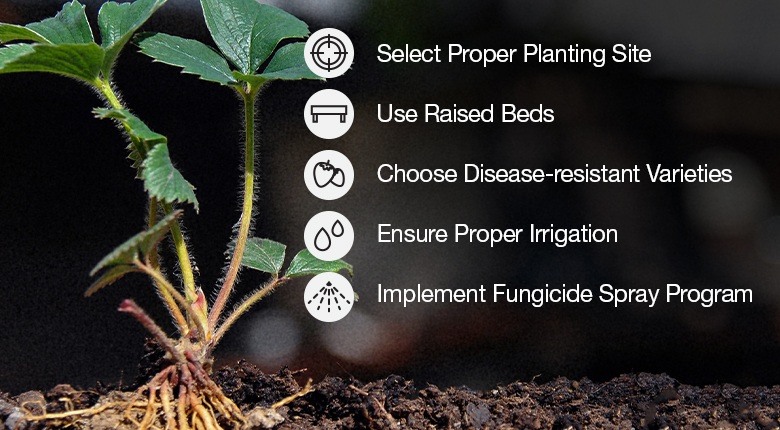Keeping Strawberries High & Dry
Prevention is key for strawberry crown and red stele root rots.

Strawberry crown and red stele root rots are both caused by soilborne oomycetes Phytophthora—Greek for “plant destroyer”—and specifically P. fragariae in red stele rot. Because the pathogens thrive in wet soil, a planting site with good drainage and no history of disease will give strawberry plants an early advantage in the field.
According to University of California IPM (UC-IPM), symptoms of crown and red stele rot include plant stunting, small leaves, brown to black roots, and brown discoloration of the crown tissue. Red stele rot indicators may also include a lack of vigor, short runners and small berries.
Because above-ground appearance of plants can mimic other diseases, diagnosis of crown or red stele rot requires removing the plant to assess the crown and roots. Infected crowns may separate from the roots as the plant is unearthed, and a vertical cross-section of a diseased crown will reveal brown discolored tissue.
Symptoms of red stele rot first appear on plants located in low, poorly drained parts of the field. Splitting an affected root above the rotted end will expose red coloration in the core of the root. Lateral roots are often rotted, and new crown roots develop a “rat tail” appearance as they die back from their tips.
Cultural controls to manage crown and red stele rot include planting in raised beds and carefully managed trickle or drip irrigation, rotation with non-host crops, and solarization of the soil. UC-IPM says soil solarization in hot months helps kill disease-causing organisms including oomycetes, nematodes and weed seeds, and makes nutrients more available to crops by speeding up the breakdown of organic matter. Consider planting resistant varieties if possible, especially if you have a history of crown or red stele rot on your farm.

Preventive fungicide applications are recommended for strawberry crown and red stele rots. Curative applications have been found far less effective, according to The American Phytopathological Society.
Orondis® Gold DC supports strong early strawberry plant establishment and healthier roots. By helping prevent crown rot and red stele root rot, these options can help early strawberry crop establishment and promote root health.
2 Min Read
- Strawberry crown and red stele root rots are the result of soilborne pathogens that thrive in wet ground.
- Because symptoms of crown and red stele rots mimic other diseases at the soil level, they must be diagnosed by removing affected plants.
- Head off strawberry crown and red stele rots by using a preventive, soil-applied fungicide.
More Articles About Field Insights
RECOMMENDED FOR YOU
2 Min Read


















